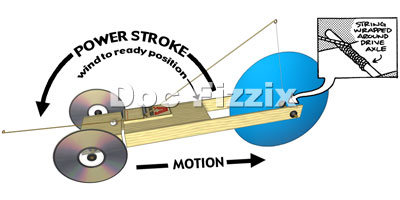Re: Mousetrap Vehicle B
Posted: November 4th, 2019, 6:33 am
Is there a reverse direction need or pushing the cup is needed in 2020 MouseTrapVehicle B challenge? Is there an official rules defined somewhere?
Thanks,
Pasi
Thanks,
Pasi
It must be in the "ready to run configuration" meaning however your vehicle will start is how it has to fit in the 40x40 square. In other words yes, all 4 wheels must touch the ground when ready to run and thus when measured.Epicbanna4 wrote: ↑November 4th, 2019, 3:06 pm Rule 3.e states, "In the ready to run configuration, all wheels/treads (in their entirety) must fit in a 40.0 cm x 40 cm space of any height and any orientation." Does that mean you could set your vehicle upright like its doing a wheelie, and make your vehicle infinitely long? Or do all 4 wheels have to be touching the ground?
Alright. So the rules state that the jaw/hammer must not extend 1 cm longer than the wooden base of the mousetrap. The metal Jaw/hammer cannot be modified (like bending, cutting, melting, etc.) to achieve better mechanical advantage. However, yes, people have added a drive arm to the jaw/hammer. Hopefully that helps. Good luck!mdejong wrote: ↑November 6th, 2019, 8:47 am Clarification question. Construction Parameter 3a. state that "No part of the jaw/hammer may extend more than 1.0 cm beyond the base." Then goes on to state, "Items may be added to the mousetrap through methods including, but not limited to: soldering, taping........"
Most designs that I have seen include an added length of material to the "jaw/hammer" that extends the distance traveled in order to apply the force to the axle more effectively than with the regular jaw/hammer. Does this rule mean that we cannot extend more than 1 cm beyond the base, or does it mean that the original jaw/hammer cannot extend more than 1cm beyond the base? Thanks in advance.

Why is this 1cm jaw/hammer even a rule? Are there mousetraps where the metal snapper (aka jaw) does not snap down completely on the wood base? I wouldnt think for an optimal mouse stike, there would need to be a solid surface under the jaw, not one that sticks out past the base.Epicbanna4 wrote: ↑November 14th, 2019, 8:27 pmAlright. So the rules state that the jaw/hammer must not extend 1 cm longer than the wooden base of the mousetrap. The metal Jaw/hammer cannot be modified (like bending, cutting, melting, etc.) to achieve better mechanical advantage. However, yes, people have added a drive arm to the jaw/hammer. Hopefully that helps. Good luck!mdejong wrote: ↑November 6th, 2019, 8:47 am Clarification question. Construction Parameter 3a. state that "No part of the jaw/hammer may extend more than 1.0 cm beyond the base." Then goes on to state, "Items may be added to the mousetrap through methods including, but not limited to: soldering, taping........"
Most designs that I have seen include an added length of material to the "jaw/hammer" that extends the distance traveled in order to apply the force to the axle more effectively than with the regular jaw/hammer. Does this rule mean that we cannot extend more than 1 cm beyond the base, or does it mean that the original jaw/hammer cannot extend more than 1cm beyond the base? Thanks in advance.

This has been seen at tournaments before.builder83 wrote: ↑November 16th, 2019, 6:55 am
Why is this 1cm jaw/hammer even a rule? Are there mousetraps where the metal snapper (aka jaw) does not snap down completely on the wood base? I wouldnt think for an optimal mouse stike, there would need to be a solid surface under the jaw, not one that sticks out past the base.
Well that makes more sense. Thanks for sharing. It still wouldn't work because of the dimension the base is required to be. But I guess they are just covering all angles with the extra rule.bearasauras wrote: ↑November 16th, 2019, 1:42 pmThis has been seen at tournaments before.builder83 wrote: ↑November 16th, 2019, 6:55 am
Why is this 1cm jaw/hammer even a rule? Are there mousetraps where the metal snapper (aka jaw) does not snap down completely on the wood base? I wouldnt think for an optimal mouse stike, there would need to be a solid surface under the jaw, not one that sticks out past the base.